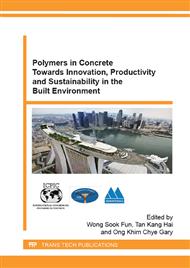p.565
p.573
p.581
p.586
p.593
p.599
p.607
p.614
p.621
Properties of Foamed Concrete Using Polymer Based Foaming Admixture
Abstract:
In Korea, about 48% of all the residents live in apartment houses and about 58% in multi-family houses share the walls and floors with their adjacent households, exposing them directly to noises. Since residents show a stronger demand for the quality of life, the number of civil complaints and disputes on inter-floor noises is constantly increasing every year, from 114 cases in 2005 to 362 cases in 2011, which has been one of the most serious social issues so far. To develop a new technique for the reduction of floor impact sounds, in this study we have investigated how to manufacture foamed concrete having comparatively-heavyweight and high-stiffness, and evaluated the properties of foamed concrete made of different kinds of polymer-based foaming admixture and their concentrations.
Info:
Periodical:
Pages:
593-598
Citation:
Online since:
November 2015
Authors:
Price:
Сopyright:
© 2015 Trans Tech Publications Ltd. All Rights Reserved
Share:
Citation:


